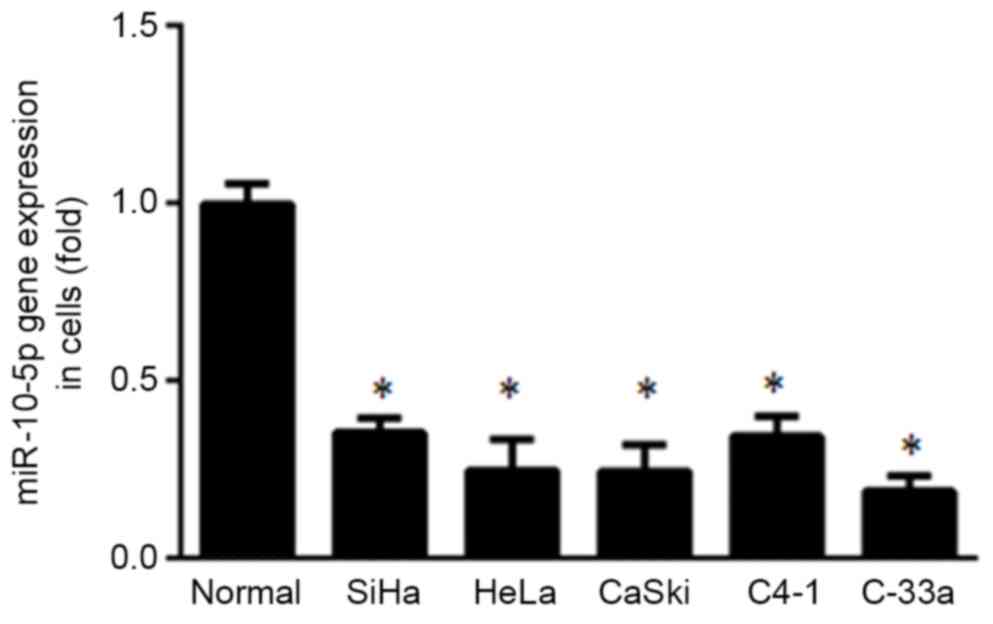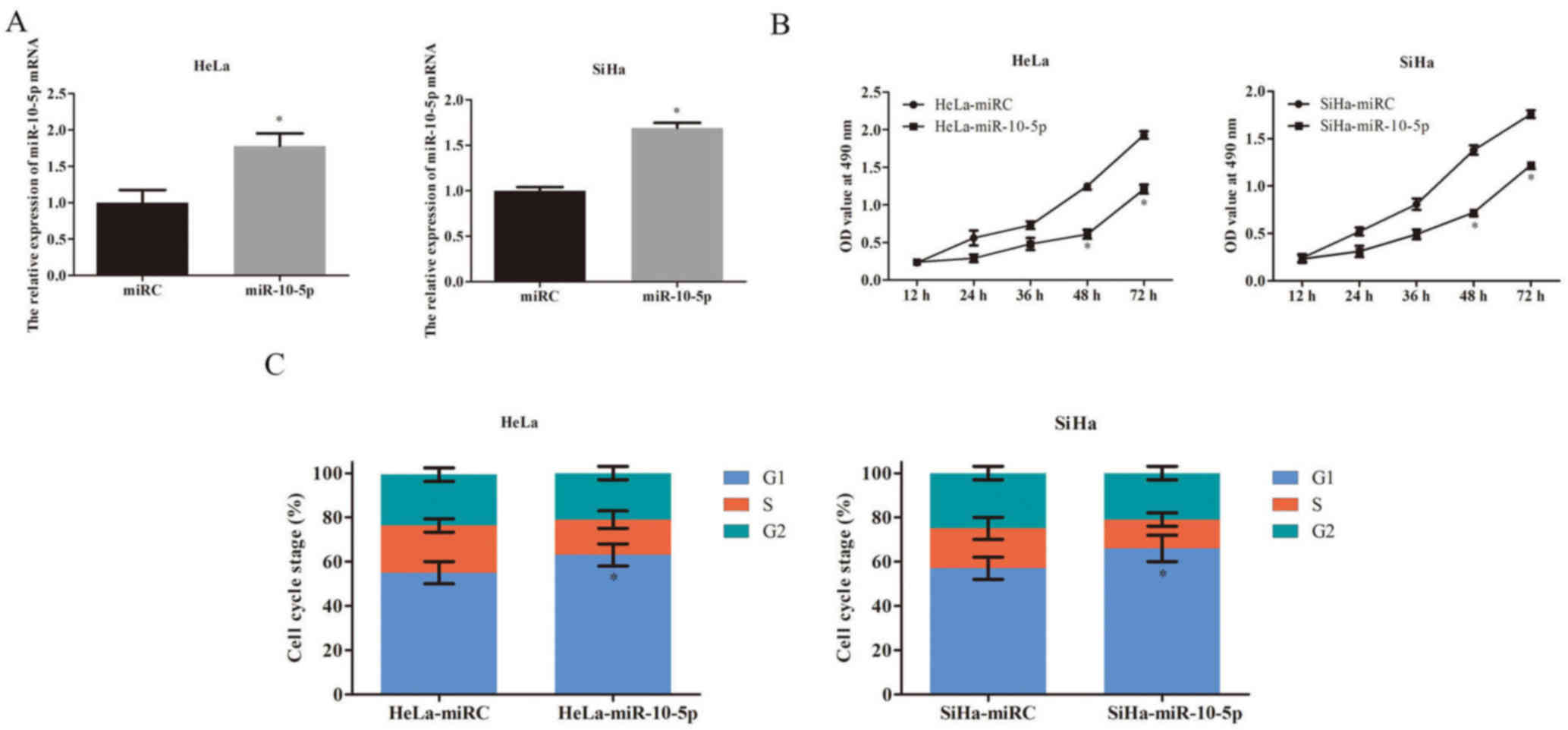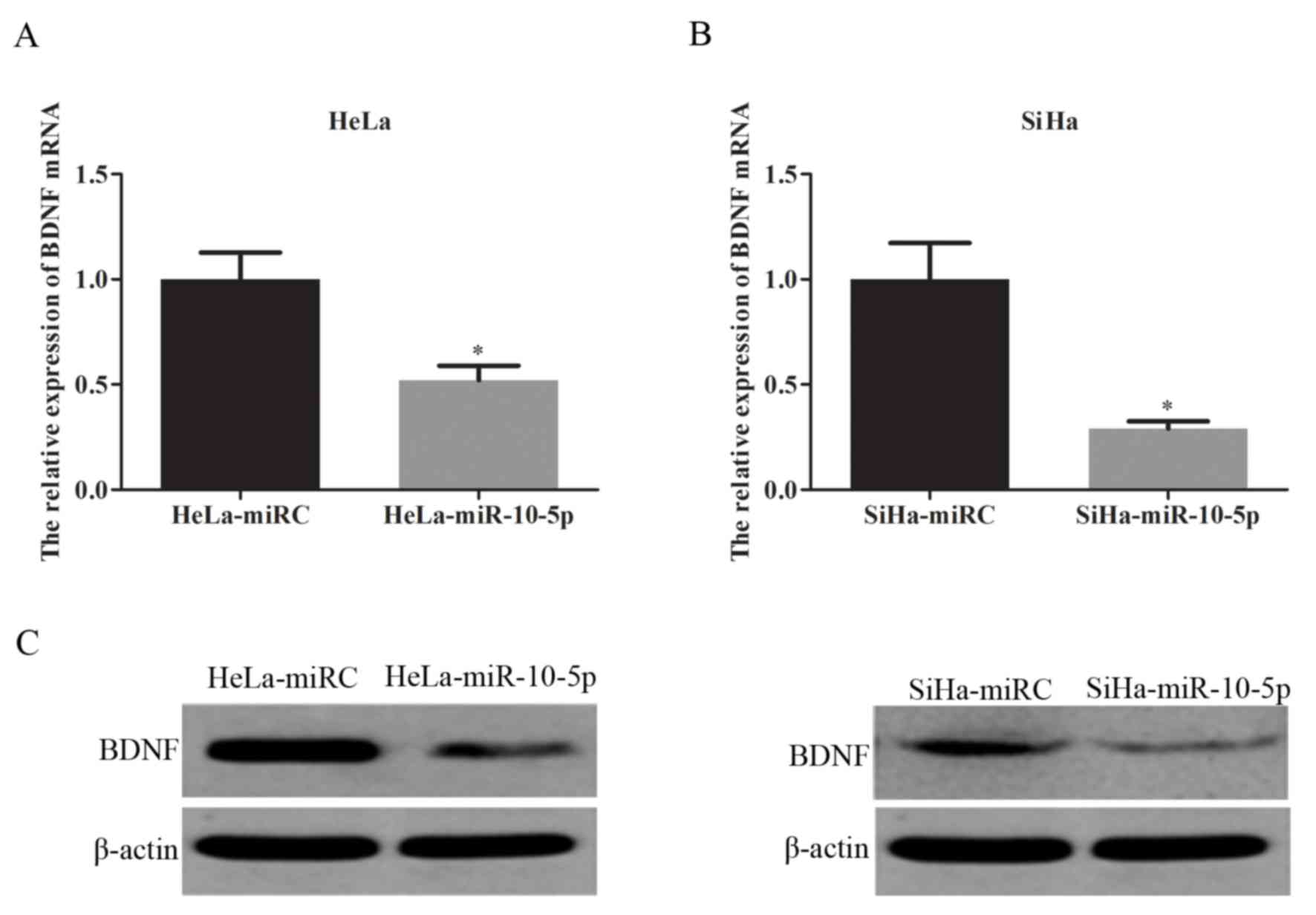MicroRNA‑10a‑5p suppresses cancer proliferation and division in human cervical cancer by targeting BDNF
- Authors:
- Published online on: October 16, 2017 https://doi.org/10.3892/etm.2017.5312
- Pages: 6147-6151
Abstract
Introduction
Cervical cancer is the second most commonly diagnosed cancer and the third leading cause of cancer-associated mortality among females in less developed countries (1). There are 527,600 new cervical cancer cases each year and 265,700 mortalities due to cervical cancer, which is the highest mortality rate of all gynecological malignancies (1,2). Cervical cancer is more prevalent in developing countries, where >85% of cases occur (3). China has the highest incidence of cervical cancer worldwide with ~140,000 new cervical cancer cases each year, accounting for ~38% of the global incidence (4).
microRNAs (miRNAs or miRs) are a type of short length, highly conservative, non-coding RNA, which are able to affect gene expression by binding to the 3′-untranslated region of target genes (5). miRNAs may act as either oncogenic factors or tumor suppressors in various types of cancer (6). In human cervical cancer, the miR-27b cluster was previously found to serve an oncogenic role in cervical cancer by promoting proliferation and was upregulated by papillomavirus 16 E7 (7). Conversely, several miRs, including miR-646, miR-141 and miR-205, were observed to be downregulated in cervical cancer (8–10). Various miRs act as tumor suppressors, including the miR-10 family, which suppresses cancer cell proliferation and promotes cancer cell apoptosis (11,12). However, there are limited studies focusing on the relationship between miR-10-5p, another member of the miR-10 family, and cervical carcinoma.
Brain-derived neurotrophic factor (BDNF) is a transcription factor that serves a key function in the process of neural differentiation (13). Previous studies have suggested that BDNF is also a key regulator of cancer (14–16). However, little is known about the molecular pathways of BDNF in cervical cancer.
The current study aimed to investigate the association between miR-10-5p and the biological characteristics of cervical cancer cell lines. The results indicated that upregulation of miR-10-5p has inhibitory effects on cervical cancer. In addition, it was demonstrated that the pro-oncogenic gene BDNF was suppressed by upregulation of miR-10-5p in cervical cancer cells.
Materials and methods
Cervical cancer cell culture
Five cervical cancer cell lines were studied: SiHa, HeLa, CaSki, C4-I and C-33a. These cell lines were all obtained from the American Type Culture Collection (Manassas, VA, USA). Normal cervical epithelial cells from the human uterus were purchased from ScienCell Research Laboratories (San Diego, CA, USA). All cells were cultured in Dulbecco's modified Eagle's medium (DMEM), high-glucose, supplemented with 10% fetal calf serum (both from Invitrogen; Thermo Fisher Scientific, Inc., Waltham, MA, USA) in a tissue culture incubator at 37°C with 5% CO2 until 90% confluence was reached. All specimens were immediately snap-frozen in liquid nitrogen and stored at −80°C for subsequent experimentation.
RNA extraction and reverse transcription-quantitative polymerase chain reaction (RT-qPCR)
Total RNA (2 µg) from cervical cell lines was extracted using TRIzol reagent (Invitrogen; Thermo Fisher Scientific, Inc.). A SuperScript™ one-step RT-PCR kit (Invitrogen; Thermo Fisher Scientific, Inc.) was used to perform RT-qPCR. For reverse transcription, the first strand was synthesized using oligo (dT) primers, DEPC-treated water, reverse transcriptase buffer, dNTPS mixture, RNase inhibitor and reverse transcriptase. The reaction steps were set by incubating at 42°C for 1 h followed by a 10 min incubation at 92°C to denature the reverse transcriptase (Invitrogen; Thermo Fisher Scientific, Inc.) and separate complementary strands. cDNA was subsequently used to perform PCR using β-actin as an internal control. The sequences of the primers used were as follows: miR-10-5p, 5′-UACCCUGUAGAUCCGAAUUUGUG-3′; BDNF forward, 5′-CTACGAGACCAAGTGCAATCC-3′ and reverse, 5′-AATCGCCAGCCAATTCTCTTT-3′; and β-actin forward, 5′-CTCCATCCAGGCGCTGT-3′ and reverse, 5′-GCTGTCACCTTCACCGTTCC-3′. qPCR was performed in a total final 20 µl volume consisting of 0.5 µl cDNA, 1 µl Taq polymerase, 1.1 µl TaqMan probe, 0.4 µl, 10 nM dNTPs, 2 µl 10× PCR buffer and 15 µl DEPC-treated water. The thermocycling conditions of PCR were performed as follows: 95°C for 10 min; 65°C for 45 sec; 72°C for 1 min, for 35 cycles. All reactions including control groups were performed in triplicate. The results were analyzed by 2−ΔΔCq method (17).
Lentivirus production
In the present study, human miR-10-5p was transfected into lentivirus (lentimiR10a-5p) and empty lentivirus lenti-miRNA control (mi-RC) was used as a negative control. All products were purchased from SunBio Biotech, Co., Ltd. (Beijing, China). Lenti-miR-10a-5p or lenti-miRC [100 nM; GenScript (Nanjing) Co., Ltd., Nanjing, China] were then transduced into HeLa and SiHa cells using Lipofectamine 2000 (Biomics Biotechnologies Co., Ltd., Nantong, China) following a previously published protocol (18). HeLa and SiHa cells were selected from the five cell lines studied to determine miR-10-5p expression levels. HeLa and C4-1 cells were HPV-18 infected cervical carcinoma cell lines and SiHa and CaSki were HPV-16 infected cells, while C-33a was a HPV negative cell line. Additionally, HeLa and SiHa were from the local cervical cancer tissues, while C4-1 and CaSki were from metastatic tissues. CaSki and C4-1 cells were difficult to culture, therefore SiHa and HeLa cells were selected to conduct the following experiments. All cells were cultured in a 6-well plate (3×105) using DMEM with 5 µg/ml puromycin at 37°C with 5% CO2 for 48 h prior to subsequent experimentation.
Cervical cancer cell viability assay
The viability of HeLa and SiHa cells was evaluated using an MTT assay (Invitrogen; Thermo Fisher Scientific, Inc.), according to the manufacturer's protocol. In a 96-well plate (5,000 cells/well), lentivirus-transduced HeLa and SiHa cells were maintained for 5 days at 20°C. All cervical cancer cell lines were incubated with a volume fraction of 10% FBS DMEM culture liquid at 37°C and 5% CO2. Cells were collected from the plates using trypsin and washed with PBS. Cell viability was measured using an MTT assay kit (Beyotime Institute of Biotechnology, Haimen, China) and the optical density at a wavelength of 490 nm was detected using a microplate reader (Multiskan MK3; Thermo Fisher Scientific, Inc.).
Cervical cancer cell cycle analysis
The HeLa (3×104) or SiHa cells (3×104) lentiviral transfected with miR-10-5p or the mi-RC controls were placed in a 10 ml centrifuge tube with 100 µl PBS suspension and 1 ml 75% ethanol. Cells were then fixed overnight at 4°C. Cells were separated by centrifugation at 8,000 × g for 5 min at 4°C. The supernatant was removed by aspirating and the pellet was washed with PBS, then subjected to centrifugation 8,000 × g for 5 min at 4°C. Cells were digested for 15 min with RnaseA (cat no. R4875; Yushen Biotechnology Co., Ltd., Taichung, Taiwan), then stained for 10 min with propidium iodide. The cell cycle was evaluated using FACSCalibur flow cytometry (BD Biosciences, Franklin Lakes, NJ, USA), and the results were analyzed using Multicycle AV 1.0 software (Phoenix Flow Systems, San Diego, CA, USA).
Western blot analysis
For western blot analysis, cells from the control and miR-10-5p groups were lysed with lysis buffer (Beyotime Institute of Biotechnology) according to the manufacturer's protocol. Proteins were isolated by centrifugation at 13,000 × g at 5°C for 5 min. A BCA kit (Shanghai Qcbio Science and Technologies Co., Ltd., Shanghai, China) was utilized for protein quantification according to the manufacturer's protocol. A total of 50 ng protein was then loaded on to each lane for SDS-PAGE. The concentrations of stacking and resolving gel were 5 and 15% respectively. Following SDS-PAGE, proteins were transferred to PVDF membranes [cat no. L03014; GenScript (Nanjing) Co., Ltd.]. Blocking was performed with 5% dry milk for 1 h at room temperature. Rabbit anti-BDNF antibody (1:200, cat no. sc-20981; Sigma-Aldrich; Merck KGaA, Darmstadt, Germany) was used as the primary antibody and was incubated at 4°C overnight. Goat anti-rabbit horseradish-peroxidase conjugated antibody [1:1,000 dilution, cat no. A00098; GenScript (Nanjing) Co., Ltd.] was used as the secondary antibody. The internal control was β-actin (1:1,000 dilution, cat no. sc-7210; Sigma-Aldrich; Merck KGaA). Incubation with the secondary antibody was 45 min at room temperature. The membranes were washed with 10X TBST (cat no. P0231; Beyotime Institute of Biotechnology) three times and visualized using an enhanced chemiluminescence film system according to the manufacture's protocol (GE Healthcare Life Sciences, Little Chalfont, UK).
Statistical analysis
Data are presented as the mean ± standard deviation. Comparisons between two groups were evaluated using the two-tailed Student's t-test with SPSS 19.0 software (SPSS Inc., Chicago, IL, USA). P<0.05 was considered to indicate a statistically significant difference.
Results
miR-10-5p expression in cervical cancer cells and normal cervical cells
miR-10-5p expression was evaluated in five cervical cancer cell lines (SiHa, HeLa, CaSki, C4-1 and C-33a) and normal cervical cells using RT-qPCR. It was demonstrated that miR-10-5p expression was significantly lower in all cervical cancer cell lines compared with normal cervical cells (P<0.05; Fig. 1).
Effect of miR-10-5p on the viability and cell cycle of cervical cancer cells
As miR-10-5p was significantly downregulated in cervical cancer cells compared with normal cervical cells, it was hypothesized that overexpression of miR-10-5p may have an inhibitory effect on the viability of cervical cancer cells. Therefore, miR-10-5p was upregulated in HeLa and SiHa cells using lentiviral miR-10-5p. Compared with lentiviral miRC, lentiviral miR-10-5p caused a significant increase in the expression of miR-10-5p in both HeLa and SiHa cells (P<0.05; Fig. 2A).
An MTT assay indicated that overexpression of miR-10-5p was able to significantly reduce cell viability at day 4 and 5 compared with the control in HeLa and SiHa cells (P<0.05; Fig. 2B). To better understand its inhibitory mechanism, the effect of miR-10-5p overexpression on cervical cancer cell cycle regulation was evaluated by flow cytometry. The results indicated that miR-10-5p overexpression suppressed cervical cancer cell cycle progression, as significantly more HeLa and SiHa cells were arrested at G1 stage in miR-10-5p-upregulated cells compared with the control (P<0.05; Fig. 2C).
BDNF mRNA and protein expression in cells
BDNF is a target gene of miR-10-5p (19). The current study aimed to investigate the association between BDNF and miR-10-5p in two different cervical cancer cell lines (HeLa and SiHa). BDNF mRNA expression was evaluated using RT-qPCR and BDNF protein expression was assessed by western blot analysis. The results indicated that overexpression of miR-10-5p significantly inhibited BDNF mRNA expression in HeLa (P<0.05; Fig. 3A) and SiHa cells (P<0.05; Fig. 3B) compared with the control. miR-10-5p overexpression also suppressed BDNF protein expression in HeLa and SiHa cells compared with the control (Fig. 3C).
Discussion
miRNA has previously been identified as an important factor in cell proliferation, division, metastasis or apoptosis in cervical cancer (20). In the present study, it was demonstrated that miR-10-5p was significantly downregulated in cervical cancer compared with normal cervical cells. A previous study reported that miR-10-5p was downregulated in chronic laryngeal epithelial premalignant lesions (21).
The current study indicated that the overexpression of mir-10a-5p reduced cell viability and delayed cell cycle progression in cervical cancer cells. In laryngeal epithelial premalignant lesions, miR-10-5p induced cancer cell apoptosis (21). The current findings are consistent with the aberrant downregulation of miR-10-5p in cancer and support the proposal that miR-10-5p has a tumor suppressor role in various types of cancer.
In the present study, it was identified that BDNF was a target gene of miR-10-5p in cervical cancer cells. In previous studies, it was proposed that miR-10a/10b targeted cell apoptosis or cell division related genes, such as MIB1 LPO, to induce apoptosis and cell cycle arrest (22,23). Therefore, the current study aimed to explore the relationship between miR-10a-5p and BDNF in the development of cancer. In some types of cancer, BDNF may act as an oncogene. Suppressing BDNF expression has been reported to inhibit cancer proliferation (14,24).
The current results indicated that upregulation of miR-10-5p expression decreased viability and inhibited cell cycle progression in cervical cancer cell lines. It was also indicated that BDNF was the target gene of miR-10-5p, and therefore miR-10-5p may be a key cervical cancer regulator. These data may help to identify novel molecular pathways to provide targeted gene therapy for cervical cancer patients.
References
|
Torre LA, Bray F, Siegel RL, Ferlay J, Lortet-Tieulent J and Jemal A: Global cancer statistics, 2012. CA Cancer J Clin. 65:87–108. 2015. View Article : Google Scholar : PubMed/NCBI | |
|
Nam EJ, Kim JW, Hong JW, Jang HS, Lee SY, Jang SY, Lee DW, Kim SW, Kim JH, Kim YT, et al: Expression of the p16INK-4a and Ki-67 in relation to the grade of cervical intraepithelial neoplasia and high-risk human papillomavirus infection. J Gynecol Oncol. 19:162–168. 2008. View Article : Google Scholar : PubMed/NCBI | |
|
Oluwole OP, Okoyomo OO, Onile TG, Alabi OO and Gbejegbe JO: Cervical carcinoma, still a burden: Histopathological analysis and review on the literature. Adv Lab Med Int. 6:1–6. 2016. | |
|
Laukkanen P, Läärä E, Koskela P, Pukkala E, Virkkunen H and Lehtinen M: Population fraction of cervical neoplasia attributable to high-risk human papillomaviruses. Future Oncol. 6:709–716. 2010. View Article : Google Scholar : PubMed/NCBI | |
|
Nilsen TW: Mechanisms of microRNA-mediated gene regulation in animal cells. Trends Genet. 23:243–249. 2007. View Article : Google Scholar : PubMed/NCBI | |
|
Zhang B, Pan X, Cobb GP and Anderson TA: MicroRNAs as oncogenes and tumor suppression. Dev Biol. 302:1–12. 2007. View Article : Google Scholar : PubMed/NCBI | |
|
Liu F, Zhang S, Zhao Z, Mao X, Huang J, Wu Z, Zheng L and Wang Q: MicroRNA-27b up-regulated by human papillomavirus 16 E7 promotes proliferation and suppresses apoptosis by targeting polo-like kinase2 in cervical cancer. Oncogarget. 7:19666–19679. 2016. View Article : Google Scholar | |
|
Wang WT, Zhao YN, Yan JX, Weng MY, Wang Y, Chen YQ and Hong SJ: Differentially expressed microRNAs in the serum of cervical squamous cell carcinoma patients before and after surgery. J Hematol Oncol. 7:62014. View Article : Google Scholar : PubMed/NCBI | |
|
Ma Q, Wan G, Wang S, Yang W, Zhang J and Yao X: Serum of microRNA-205 as a novel biomarker for cervical cancer patients. Cancer Cell Int. 14:812014. View Article : Google Scholar : PubMed/NCBI | |
|
Mi Y, Wang L, Zong L, Pei M, Lu Q and Huang P: Genetic variants in microRNA target sites of 37 selected cancer-related genes and the risk of cervical cancer. PLoS One. 9:e860612014. View Article : Google Scholar : PubMed/NCBI | |
|
Safan A, Seifolesiami M, Yahaghi E, Sedaghati F and Khameneie MK: Retracted Article: Upregulation of miR-20a and miR-10a expression levels act as potential biomarkers of aggressive progression and poor prognosis in cervical cancer. Tumour Biol. Oct 1–2015.(Epub ahead of print). | |
|
Zhang L, Sun J, Wang B, Ren JC, Su W and Zhang T: MicroRNA-10b triggers the epithelial-mesenchymal transition (EMT) of laryngeal carcinoma Hep-2 cells by directly targeting the E-cadherin. Appl Biochem Biotechnol. 176:33–44. 2015. View Article : Google Scholar : PubMed/NCBI | |
|
McAllister AK: Neurotrophins and neuronal differentiation in the central nervous system. Cell Mol Life Sci. 58:1054–1060. 2001. View Article : Google Scholar : PubMed/NCBI | |
|
Cao L, Liu X, Lin EJ, Wang C, Choi EY, Riban V, Lin B and During MJ: Environmental and genetic activation of a brain-adipocyte BDNF/leptin axis causes cancer remission and inhibition. Cell. 142:52–64. 2010. View Article : Google Scholar : PubMed/NCBI | |
|
Kaplan DR, Matsumoto K, Lucarelli E and Thiele CJ: Induction of TrkB by retinoic acid mediates biologic responsiveness to BDNF and differentiation of human neuroblastoma cells. Eukaryotic Signal Transduction Group. Neuron. 11:321–331. 1993. View Article : Google Scholar : PubMed/NCBI | |
|
Hu Z, Shen WJ, Kraemer FB and Azhar S: MicroRNAs 125a and 455 repress lipoprotein-supported steroidogenesis by targeting scavenger receptor class B type I in steroidogenic cells. Mol Cell Biol. 32:5035–5045. 2012. View Article : Google Scholar : PubMed/NCBI | |
|
Livak KJ and Schmittgen TD: Analysis of relative gene expression data using real-time quantitative PCR and the 2(-Delta Delta C(T)) method. Methods. 25:402–408. 2001. View Article : Google Scholar : PubMed/NCBI | |
|
Guo D, Hou X, Zhang H, Sun W, Zhu L, Liang J and Jiang X: More expressions of BDNF and TrkB in multiple hepatocellular carcinoma and anti-BDNF or K252a induced apoptosis, supressed invasion of HepG2 and HCCLM3 cells. J Exp Clin Cancer Res. 30:972011. View Article : Google Scholar : PubMed/NCBI | |
|
Müller S: In silico analysis of regulatory networks underlined the role of miR-10b-5p and its target BDNF in huntington's disease. Transl Neurodegener. 3:172014. View Article : Google Scholar : PubMed/NCBI | |
|
Du X, Lin LI, Zhang L and Jiang J: microRNA-195 inhibits the proliferation, migration and invasion of cervical cancer cells via the inhibition of CCND2 and MYB expression. Oncol Lett. 10:2639–2643. 2015.PubMed/NCBI | |
|
Hu Y and Liu H: MicroRNA-10a-5p and microRNA-34c-5p in laryngeal epithelial premalignant lesions: Differential expression and clinicopathological correlation. Eur Arch Otorhinolaryngol. 272:391–399. 2015. View Article : Google Scholar : PubMed/NCBI | |
|
Wang X, Ling CC, Li L, Qin Y, Qi J, Liu X, You B, Shi Y, Zhang J, Jiang Q, et al: MicroRNA-10a/10b represses a novel target gene mib1 to regulate angiogenesis. Carrdiovasc Res. 110:140–150. 2016. View Article : Google Scholar | |
|
Stadthagen G, Tehler D, Høyland-Kroghsbo NM, Wen J, Krogh A, Jensen KT, Santoni-Rugiu E, Engelholm LH and Lund AH: Loss of miR-10a activates lpo and collaborates with activated Wnt signaling in inducing intestinal neoplasia in female mice. PLoS Genet. 9:e10039132013. View Article : Google Scholar : PubMed/NCBI | |
|
Liu X, McMruphy T, Xiao R, Slater A, Huang W and Cao L: Hypothalamic gene transfer of BDNF inhibits breast cancer progression and metastasis in middle age obese mice. Mol Ther. 22:1275–1284. 2014. View Article : Google Scholar : PubMed/NCBI |












